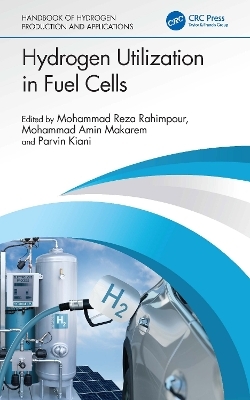
Hydrogen Utilization in Fuel Cells
CRC Press (Verlag)
978-1-032-46615-6 (ISBN)
Introduces the electrochemistry and thermodynamics of fuel cells
Provides an overview of fuel cells materials
Discusses applications of fuel cells in transportation and energy systems
Describes the role of hydrogen in various fuel cells
Details the kinetics, performance, stability, and environmental challenges of fuel cells
Part of the multivolume Handbook of Hydrogen Production and Applications, this stand-alone book guides researchers and academics in chemical, environmental, energy, and related areas of engineering interested in development and implementation of hydrogen production technologies.
Mohammad Reza Rahimpour is a Distinguished Professor of Chemical Engineering at Shiraz University, Iran. He earned a PhD in chemical engineering at Shiraz University, in collaboration with the University of Sydney, Australia, in 1988. He leads a pioneering research group specializing in fuel processing technology, with a particular focus on the catalytic conversion of both fossil fuels, such as natural gas, and renewable fuels, like bio‑oils derived from lignin, into valuable energy sources. Throughout his academic career, Dr. Rahimpour has specialized in hydrogen production technologies, including steam methane reforming, water electrolysis, photocatalytic hydrogen production, and hydrogen production from both renewable sources and fossil fuels. His extensive expertise and innovative research significantly contribute to advancements in hydrogen production and its practical applications. Mohammad Amin Makarem earned a PhD in chemical engineering at Shiraz University. His research interests include gas separation and purification, nanofluids, microfluidics, catalyst synthesis, reactor design, and green energy. Parvin Kiani earned a degree in chemical engineering at Shiraz University. Her research has focused on gas separation, clean energy, and catalyst synthesis.
Section I: Introduction to Fuel Cells. 1. Fundamentals, Characteristics, and Applications of Fuel Cells. 2. The Electrochemistry and Thermodynamics of Fuel Cells. 3. Fuel Cell Comparison to Conventional Power Generation Technologies. 4. Characterization Methods for Fuel Cells Materials and Components. Section II: Fuel Cell Materials. 5. Fuel Cell Cathodic Materials and Catalysts. 6. Fuel Cell Electrolyte Materials. Section III: Role of Hydrogen in Fuel Cells and Applications. 7. Role of Hydrogen in Polymer Electrolyte Fuel Cell Systems. 8. Role of Hydrogen in Polymer Electrolyte Membrane Fuel Cells. 9. Role of Hydrogen in Proton Exchange Membrane Fuel Cell. 10. Role of Hydrogen in Phosphoric Acid Fuel Cells. 11. Role of Hydrogen in Solid Electrochemical Cell. 12. Role of Hydrogen in Direct Methanol Fuel Cells. 13. Role of Hydrogen in Zinc–Air Fuel Cells. 14. Application of Fuel Cells in Transportation.
| Erscheinungsdatum | 25.09.2024 |
|---|---|
| Zusatzinfo | 25 Tables, black and white; 25 Line drawings, black and white; 90 Halftones, black and white; 115 Illustrations, black and white |
| Verlagsort | London |
| Sprache | englisch |
| Maße | 156 x 234 mm |
| Gewicht | 930 g |
| Themenwelt | Naturwissenschaften ► Chemie ► Technische Chemie |
| Naturwissenschaften ► Physik / Astronomie | |
| Technik ► Elektrotechnik / Energietechnik | |
| Technik ► Umwelttechnik / Biotechnologie | |
| ISBN-10 | 1-032-46615-4 / 1032466154 |
| ISBN-13 | 978-1-032-46615-6 / 9781032466156 |
| Zustand | Neuware |
| Informationen gemäß Produktsicherheitsverordnung (GPSR) | |
| Haben Sie eine Frage zum Produkt? |
aus dem Bereich


